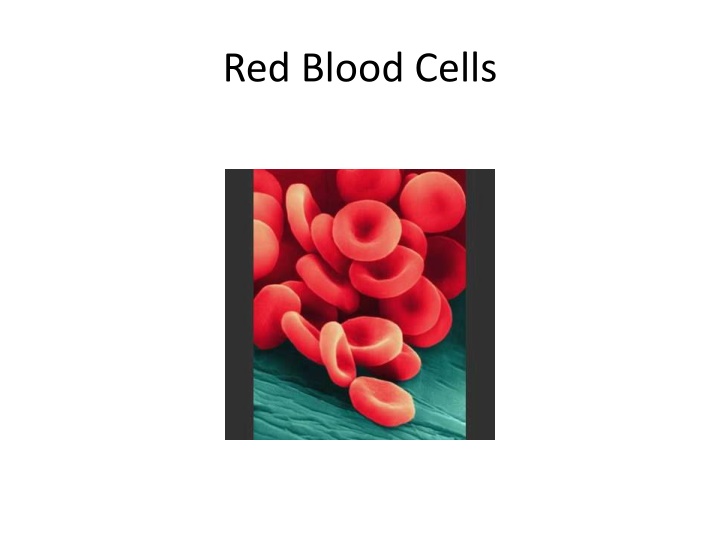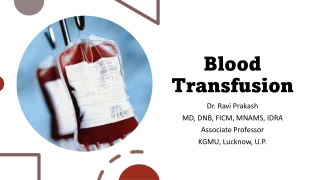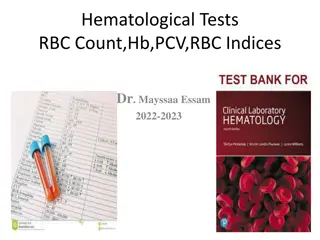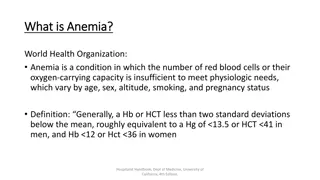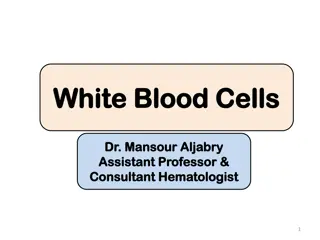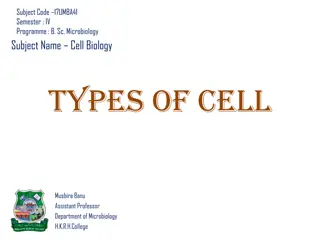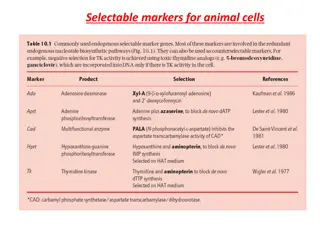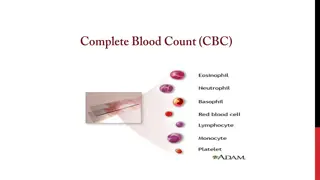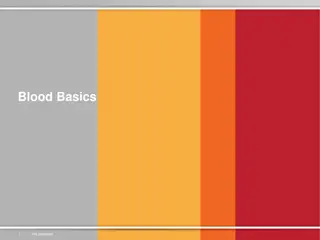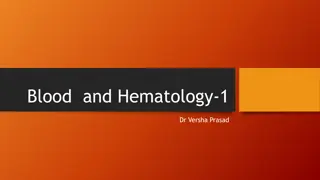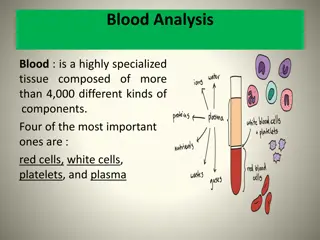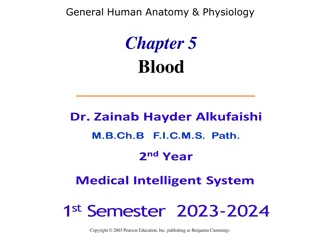Red Blood Cells
Red blood cells (RBCs) play a vital role in our body by transporting oxygen. They are tiny, flexible discs that lack a nucleus and can bend to navigate small capillaries. RBCs are constantly produced through erythropoiesis in the red bone marrow and have a lifespan of 120 days. Hemoglobin, which gives RBCs their red color, is crucial for oxygen transport and requires specific nutrients for synthesis. Anemia, a condition characterized by low RBC count and hemoglobin deficiency, can lead to symptoms like fatigue and pallor. Understand the causes and effects of conditions like sickle cell anemia and carbon monoxide poisoning on RBC function.
Download Presentation

Please find below an Image/Link to download the presentation.
The content on the website is provided AS IS for your information and personal use only. It may not be sold, licensed, or shared on other websites without obtaining consent from the author.If you encounter any issues during the download, it is possible that the publisher has removed the file from their server.
You are allowed to download the files provided on this website for personal or commercial use, subject to the condition that they are used lawfully. All files are the property of their respective owners.
The content on the website is provided AS IS for your information and personal use only. It may not be sold, licensed, or shared on other websites without obtaining consent from the author.
E N D
Presentation Transcript
Adapted exclusively for producing and packaging hemoglobin which transports oxygen Adult male: 4.6 6 million Adult female: 4.2 5 million
Red blood cells are: Tiny, flexible biconcave discs Lacks a nucleus Can bend when going through tiny capillaries
RBCs are constantly manufactured erythroposis Every second = 2.4 million RBC s Life span: 120 days Manufactured in red bone marrow of the vertebrae, ribs, sternum, skull and proximal epiphysis of long bones
Hemoglobin Gives red blood cells their red color Heme - contains iron Each hemoglobin molecule can combine with 4 molecules of oxygen Hemoglobin synthesis requires amino acids, specific enzymes, vitamins and minerals (Fe, Cu)
Anemia Deficiency of hemoglobin Lower RBC count Oxygen transport is reduced Symptoms: Tired, no energy Pale, nails are brittle
Causes: diet, loss of blood, lower production of RBC
Carbon Monoxide Poisoning Carbon Monoxide combines with hemoglobin 200X more readily thank oxygen. Smokers have 4.5% less oxygen than non smokers
Sickle Cell Anemia Mutation in the gene for making hemoglobin Makes the wrong shape cell Primarily affects people of African decent Carriers do not have the disease Persons with 2 mutant genes, have the disease, but can fight off the Malaria parasite
Thalassemia Inherited disease A decrease in one or more hemoglobin polypeptide chain Mainly in persons of Mediterranean, African or Southwest Asia Results in severs anemia Treated with blood transfusions
Leukocytes Defend body against disease causing agents Have a nucleus Develop from stem cells in red bone marrow Performs duties in various body tissue Phagocytize (eat) dead cells, bacteria and foreign matter Normal count: 7000 WBC per cubic ml of blood
3 types of granular leukocytes: contain enzymes that destroy bacteria
Neutrophil 60% of WBC Lifespan is 10 hours in blood Seek out and destroy ingested bacteria in connective tissues 100 billion manufactured daily
Eosinophil 1-3 % of WBC Help control allergic reactions Release an enzyme histamine a chemical released during allergic reactions
Basophil Less than 1% of WBC Involved in allergic and inflammatory reactions Contains large amounts of histamines which may be released in injured tissue in order to increase inflammation Contains heparin an anti-clotting chemical
Non-Granular Leukocytes Lymphocytes 30% of all leukocytes Made from stem cells, but are released from lymph nodes, thymus and spleen Produce antibodies and destroy foreign cells found in infectious mononucleosis
Monocyte 6% of WBC s Enter connective tissue Eat bacteria, dead cells and other littering tissue
Abnormal WBC count A count over 10,000 per cubic ml is called leukocytosis. Indicates a bacterial infection Viruses- depresses WBC count - leukopenia
Leukemia Form of cancer in which any one kind of WBC proliferates wildly within the bone marrow Increases number of WBC which crowds out RBC s and platelets leading to anemia and impaired blood clotting Dramatic increase in WBC count, but many WBC s are immature or abnormal and unable to protect the body against disease Death is usually from bacterial infections
